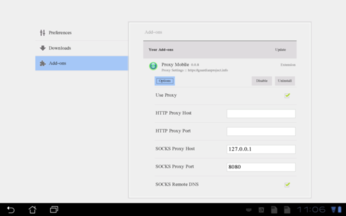SSH Tunneling on Android for Secure Web Browsing

Productivity Sauce
When you are on the move, you can easily secure your Internet connection by setting up an SSH tunnel, provided you have a remote SSH server to connect to. Creating an SSH tunnel on Linux is a matter of executing the ssh -ND 9999 user@remotehost command in the terminal. But what if you are using an Android device when you are out and about? ConnectBot has got you covered. This SSH client app can be used to set up an SSH tunnel by configuring a so-called port forward. To do this, launch ConnectBot and establish a connection to an SSH server.
Press then the Menu button and tap on Port Forwards. Press again Menu and tap on Add port forward. Give the new port forward a name, select Dynamic (SOCKS) from the Type list, and specify the desired source port (e.g., 8080), and press the Create port forward button. From now on, ConnectBot will automatically establish an SSH tunnel every time you connect to the remote SSH server.
To use the SSH tunnel you need a browser that supports proxy servers. To enable proxy support in the Mozilla Firefox browser for Android, you need to install the Proxy Mobile add-on. In Firefox, switch to the Add-ons section, search for Proxy Mobile and install the add-on. Restart the browser and switch to the add-on Options section. Enter 127.0.0.1 to the SOCKS Proxy Host field and 8080 to the SOCKS Proxy Port field. That's all there is to it. You can now browse the web through the established SSH tunnel.
Comments
comments powered by DisqusSubscribe to our Linux Newsletters
Find Linux and Open Source Jobs
Subscribe to our ADMIN Newsletters
Support Our Work
Linux Magazine content is made possible with support from readers like you. Please consider contributing when you’ve found an article to be beneficial.

News
-
Another Linux Malware Discovered
Russian hackers use Hyper-V to hide malware within Linux virtual machines.
-
TUXEDO Computers Announces a New InfinityBook
TUXEDO Computers is at it again with a new InfinityBook that will meet your professional and gaming needs.
-
SUSE Dives into the Agentic AI Pool
SUSE becomes the first open source company to adopt agentic AI with SUSE Enterprise Linux 16.
-
Linux Now Runs Most Windows Games
The latest data shows that nearly 90 percent of Windows games can be played on Linux.
-
Fedora 43 Has Finally Landed
The Fedora Linux developers have announced their latest release, Fedora 43.
-
KDE Unleashes Plasma 6.5
The Plasma 6.5 desktop environment is now available with new features, improvements, and the usual bug fixes.
-
Xubuntu Site Possibly Hacked
It appears that the Xubuntu site was hacked and briefly served up a malicious ZIP file from its download page.
-
LMDE 7 Now Available
Linux Mint Debian Edition, version 7, has been officially released and is based on upstream Debian.
-
Linux Kernel 6.16 Reaches EOL
Linux kernel 6.16 has reached its end of life, which means you'll need to upgrade to the next stable release, Linux kernel 6.17.
-
Amazon Ditches Android for a Linux-Based OS
Amazon has migrated from Android to the Linux-based Vega OS for its Fire TV.



tunneling
not proxydroid, but something from same dev
proxydroid
proxydroid is another alternative which will set the proxy server for all running android applications.